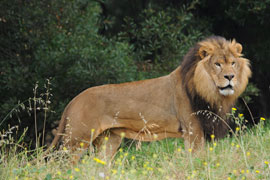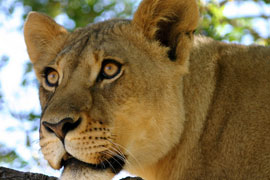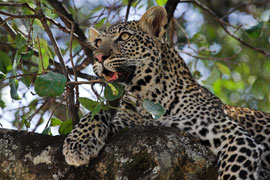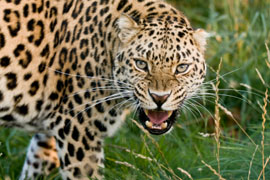South Africa Information
South African Wildlife
Our South African wildlife gallery represents a small sample of the hundreds of species of wildlife found in South Africa. (The term 'wildlife' refers to mammals, birds, fish and reptiles that can be found in the wild). There are 299 mammal species in South Africa, of which 2 are critically endangered, 11 are endangered, 15 are vulnerable, and 13 are near-threatened (conservation status as assessed by the IUCN).
To learn more about the individual wildlife species that can be enjoyed whilst visiting South Africa and enjoy the wildlife photos in the galleries please use the drop down list in the menu on the right or browse through the information provided below.
To learn more about the individual wildlife species that can be enjoyed whilst visiting South Africa and enjoy the wildlife photos in the galleries please use the drop down list in the menu on the right or browse through the information provided below.
South Africa Wildlife
The Lion {Panthera Leo}

The Lion
Most cat species live a fundamentally solitary existence, but the lion is an exception. It has developed a social system based on teamwork and a division of labour within the pride, and an extended but closed family unit centres around a group of related females. The average pride consists of about 15 individuals, including five to 10 females with their young and two or three territorial males that are usually brothers or pride mates.
Quick Facts
Size: Lion stand 48 inches high at the shoulder.
Adult male lion weigh about 416 pounds.
Female lions weigh 277 pounds.
Male Lions: Male lions are typically 4 feet in height with a large mane of hair that begins to develop around age two that surrounds the neck. The mane can vary in colour from tawny/tan to black.
Females: Females are 44 inches in height, and have no mane around their neck. Cubs are born with a slightly spotted coat, that changes to their parents tawny coloration around three months of age. Female lions live longer than males, and Serengeti female lions can live up to age 18, whereas males typically live to age 12.
Habitat: Lions are found in savannahs, grasslands, dense bush and woodlands.
Diet: Carnivore
Diet Description: Lions are opportunists when it comes to feeding. They will scavenge from other predators that have killed an animal, or will hunt animals ranging in size from the large African buffalo to a small hare.

The Lion
A pride can range from three to 30 individuals, but tend to average about fifteen members, which include male and female lions plus a number of cubs. The number of lions in a pride will vary significantly based on the number of prey animals that live or migrate through the pride's territory.
Reproduction: Cubs are born after a gestation period of 110 days, with female lions giving birth in a den site, typically located in a rock outcrop or in dense vegetation. A female will on average give birth to three cubs that are between 2 to 4 pounds in weight.
South Africa Wildlife
Leopard {Panthera Pardus}

The Leopard
The coloring of the leopard varies from white to bright golden brown, spotted with black spots and rosettes. The rosettes consist of groups of 5 to 6 spots arranged in a tight ring.
The tail is longer than half the body length measured from head to tail. This fierce animal has small round ears and long whiskers growing from dark spots on the upper lip. The size of the leopard varies considerably. The leopard differs from the cheetah in having shorter legs, and rosette-like spots and is without the cheetah’s black "tear" marks from eye to mouth.
Quick Facts
Name: Panthera Pardus
Size: The leopard ranges in size from 1 to almost 2 metres long, and weighs between 30 - 70 kg. Females are typically around two-thirds the size of males.
Diet: Carnivorous; Small animals and medium size antelope.
Habitat: Bush and riverine forests. Usually in or near thickets on mountain sides or along streams and rivers. Leopards are mainly nocturnal animals but are also seen during the day, especially in the early mornings and late afternoons. They usually forage alone except in the mating season.

The Leopard
Socialisation: Leopards are basically solitary and go out of their way to avoid one another. Each animal has a home range that overlaps with its neighbors; the male's range is much larger and generally overlaps with those of several females. A leopard usually does not tolerate intrusion into its own range except to mate. Unexpected encounters between leopards can lead to fights.
Reproduction: Leopard breed throughout the year.
Gestation: The gestation period is 3 months. Number of young is 2 to 3 although more have been recorded.
Life Expectancy: 20 years,,,

No comments:
Post a Comment